Why smokes a gas stove with a propane tank: basic breakdowns and troubleshooting tips
Gas equipment provides comfort when cooking and is quite simple to operate. And the cost of energy is affordable. Where there is centralized gas supply, there are no difficulties with the supply of fuel. In small settlements, in country cooperatives, there are no central networks; the population uses cylinders to provide power to gas appliances.
The quality of the bottled gas is somewhat different from that supplied centrally, and the owners of the stoves may notice that the burners are not working properly. Understanding why a gas stove smokes, it is worth considering that not all malfunctions can be eliminated independently. In most cases, the help of a qualified professional will be required.
In this article, we will talk about the main causes of soot and options for fixing the breakdown. We also note in which cases you should immediately contact specialists.
The content of the article:
The main causes of soot
The gas stove works normally if the flame in the burner is of natural blue color, without impurities of red and / or yellow hue. When multi-colored tongues appear in the flame, the gas is supplied unevenly, then this work cannot be called correct. A reddish shade of flame indicates that the fuel does not completely burn out or there is not enough air to burn gas.
The presence of red flames often precedes the appearance of soot.
The reason for this unpleasant phenomenon is:
- low gas quality;
- high / low pressure.
When the gas mixture contains too much mercaptan sulfur, thick, black smoke appears, particles of which settle on the dishes, the walls of the room.
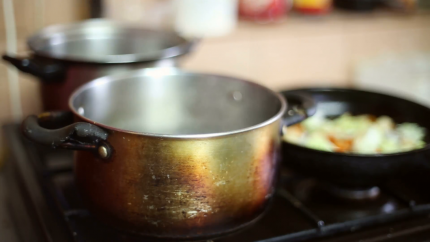
A similar situation is noted when connecting the stove to a low-quality cylinder with a low gas content. In some cases, soot appears in the presence of malfunctions of the burner itself.
Consider the main reasons in more detail.
Reason # 1 - poor fuel quality
Understanding why soot appears from a working gas stove, it is important to know that the cylinders are refueling gas mixture. When the composition contains a high sulfur content, soot appears.
If you are absolutely sure that poor fuel was the cause of the soot, you can file a complaint with Rospotrebnadzor and other organizations of a similar profile.
Together with the application you will need to provide:
- receipt issued during refueling;
- the tank itself (cylinder) with low-quality fuel for examination.
Often, such incidents are resolved peacefully in favor of gas consumers. You do not know what to do when a gas stove working from a cylinder smokes and what measures can be taken without delay?
Then remember a simple algorithm:
- try moving the bottle or gas stove to another location;
- if you have friends who use the services of the same organization that refills the cylinders, check if the gas stove smokes from them;
- contact your fuel supplier to explain the increased sulfur content in the gas mixture;
- in the absence of contact with the organization that refills the cylinders, write a complaint with a request to restore justice, to compensate for the value of property damaged by soot.
When starting a trial with a fuel supplier, make sure there is a problem in the quality of the gas. We also recommend that you familiarize yourself with the requirements for refueling cylinders and filling standards.

In addition to problems with gas supplies, the reason for soot is often the need to adjust the equipment and eliminate malfunctions.
Reason # 2 - incorrect stove settings
Understanding why a household gas stove smokes, connected to a propane tankIt is important to evaluate the level of pressure in the system. It depends not only on the quality of the container, but also on the features of the burner. To deal with the problem, it is important to know the device last.
A burner consists of the following elements:
- Divider - Designed for uniform distribution of fuel along the entire perimeter of the burner. In appearance, the divider resembles a sleeve that is cut along the contour.
- Divider cover provides the desired diameter, looks like a round-shaped lid made of stainless steel, located on the top of the divider.
- Electric spark plug - An element of modern gas stove models. A spark is a signal to start work, gas is ignited from it. A candle is located on the side of the divider, a temperature sensor is located nearby, which ensures the safe operation of the stove. If the fire goes out, a command is sent to a special electromechanical device,
- Jet located under the divider, looks like a small bolt having a through axial hole. The nozzle is responsible for uniform fuel supply, regulates the pressure.
The appearance of soot, the incorrect operation of the gas stove - all this is often associated with the installed nozzle, or rather, with too large a hole in it.
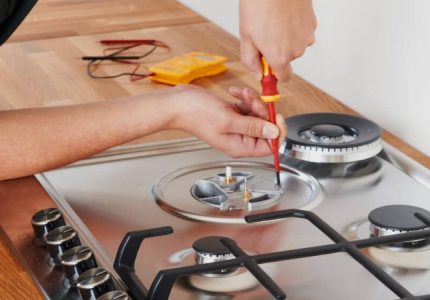
Uneven fuel supply may be due to blockages. To clean the nozzle, carefully insert a thin wire into the hole, twist it between your fingers. Pressing, picking the nozzle is not recommended. This can lead to an increase in the hole, the appearance of soot.
If there is dirt, do not forget to clean other parts as well, as soot can appear as a result of burning deposits accumulated on the burner surfaces.Rub all elements well with an old toothbrush dipped in detergent. Then rinse the parts under running water, dry well. Only then proceed with the assembly of the gas stove.
Reason # 3 - insufficient air volume
Not enough amount of air, which is fed to the burner, will lead to the appearance of soot even when all other elements are in good condition. To adjust the air disks, it is necessary to unscrew the locking screw, act very carefully.
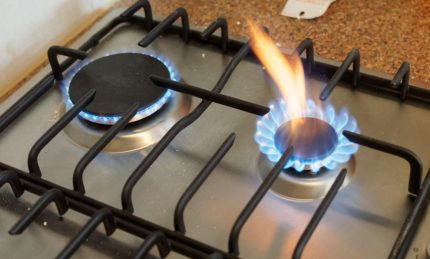
Upon completion of the adjustment of the air disks, you must immediately check the quality of the gas stove.
When you turn on the burner, the gas must burn without extraneous sounds, buzzing. Tongues of flame should not be more than 2.5 cm in height. If the adjustment did not help, it is worth returning the air disks to their original position.
When to replace the nozzle?
Modern gas stoves, for the most part, are designed for centralized gas supply. Central networks use methane, system pressure differs from the pressure in the cylinder, so a hole in the nozzle with a slightly larger diameter is necessary. When using bottled gas, propane is used to provide domestic needs, therefore a nozzle with a smaller opening is needed.
In the basic configuration, nozzles designed to supply fuel through centralized lines are always used. Modern equipment may include a spare nozzle designed for bottled gas. Also, for the use of cylinders, an additional gas reducer.
Trying to get rid of the cause of soot on the burner of a household gas stove, it is important to purchase a nozzle that matches the brand of the household appliance. Otherwise, replacing the part will not bring the expected result.
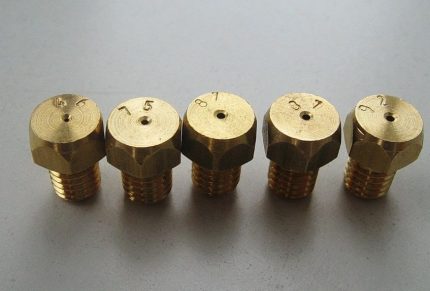
In older models of gas stoves there is no nozzle. However, they are equipped with a mechanism that allows you to adjust the intensity of fuel intake. You need to configure it correctly. Adjustment is carried out by turning the tap, which is equipped with a gas cylinder. Without unscrewing the valve to the end, it is easy to reduce the gas pressure in the system, to minimize the likelihood of soot.
In some situations, soot appears when the oven is turned on. It is likely that nozzle replacement is also needed here. In most gas stoves, the nozzle is located behind the left wall of the oven chamber, into which the burner is inserted, curved by an arc. To replace the nozzle, unscrew the screws, remove the burner, find and replace the part.
During prolonged use of a gas appliance, the nozzle could stick to the burner nozzle. In such a case, it is necessary to lubricate it with a special composition, wait a few minutes.
When the nozzle is deformed - the fuel enters the burner unevenly, soot, gas accumulation in the device is possible, which is dangerous. To replace the nozzle, you need to look at the brand of the gas stove, choose the right accessories.
It is important to remember that gas equipment is potentially dangerous, therefore, in case of any breakdowns, it is advisable to invite specialists from the gas company with which you contract signed for service.
Conclusions and useful video on the topic
The soot that appears when using a gas stove causes a lot of trouble. The reasons for this behavior of the burner may be different, but most often, they are associated with the incorrect size of the nozzle opening. The video shows how to quickly replace the nozzle, to ensure the normal operation of the gas appliance:
When the gas stove smokes, it is necessary to start the diagnosis by checking that the nozzle matches the type of fuel. If everything is in order here, you should pay attention to the quality of the fuel. It is recommended to refill cylinders only at trusted organizations. In some cases, the appearance of soot is associated with the presence of a malfunction. To find a breakdown, correctly eliminate it, it is worth inviting a professional.
Have you recently resolved a burner problem that started to smoke? Tell us what your reason for the malfunction was and how you dealt with it. If you want to supplement the above material or ask questions of interest to the article to our experts and other site visitors, write your comments in the feedback section below.

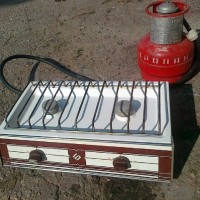 The best gas stove for giving a balloon: TOP-10 of the best models + recommendations for customers
The best gas stove for giving a balloon: TOP-10 of the best models + recommendations for customers 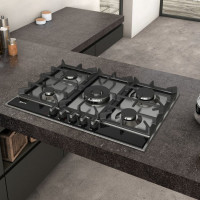 Which is better - gas stove or gas panel: criteria for comparing appliances + recommendations for customers
Which is better - gas stove or gas panel: criteria for comparing appliances + recommendations for customers 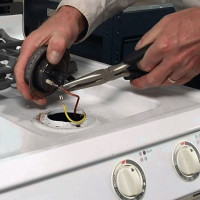 Why the gas stove does not hold the flame, the oven goes out and the burner goes out: an overview of the reasons and repair tips
Why the gas stove does not hold the flame, the oven goes out and the burner goes out: an overview of the reasons and repair tips 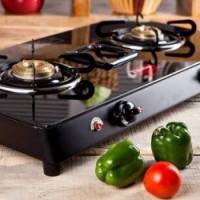 The best gas stove without an oven: the best models for 2 and 4 burners + recommendations for customers
The best gas stove without an oven: the best models for 2 and 4 burners + recommendations for customers  Why a gas meter shakes a lot: analysis of the reasons and recommendations for their elimination
Why a gas meter shakes a lot: analysis of the reasons and recommendations for their elimination 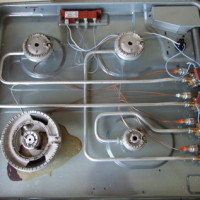 Why automatic ignition of a gas stove constantly clicks and spontaneously triggers: breakdowns and their repair
Why automatic ignition of a gas stove constantly clicks and spontaneously triggers: breakdowns and their repair  How much does it cost to connect gas to a private house: the price of organizing gas supply
How much does it cost to connect gas to a private house: the price of organizing gas supply  The best washing machines with dryer: model rating and customer tips
The best washing machines with dryer: model rating and customer tips  What is the color temperature of light and the nuances of choosing the temperature of the lamps to suit your needs
What is the color temperature of light and the nuances of choosing the temperature of the lamps to suit your needs  Replacement of a geyser in an apartment: replacement paperwork + basic norms and requirements
Replacement of a geyser in an apartment: replacement paperwork + basic norms and requirements